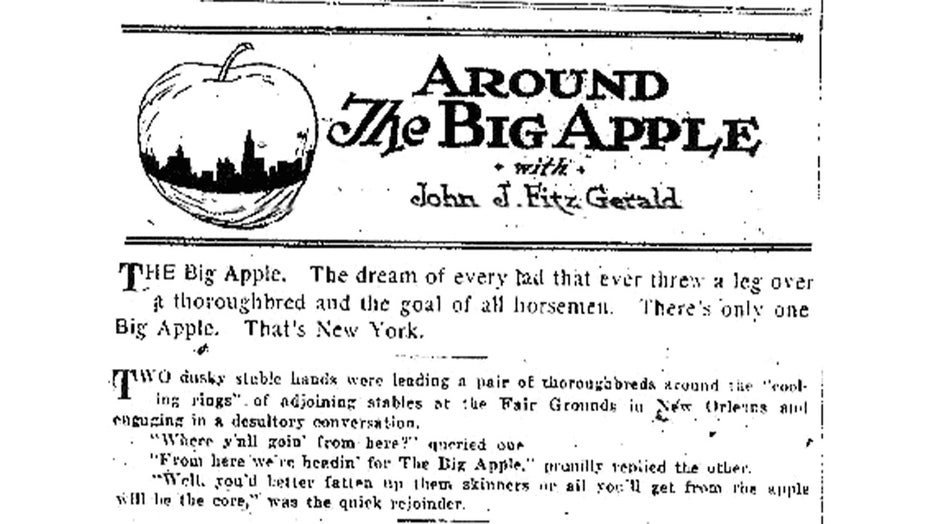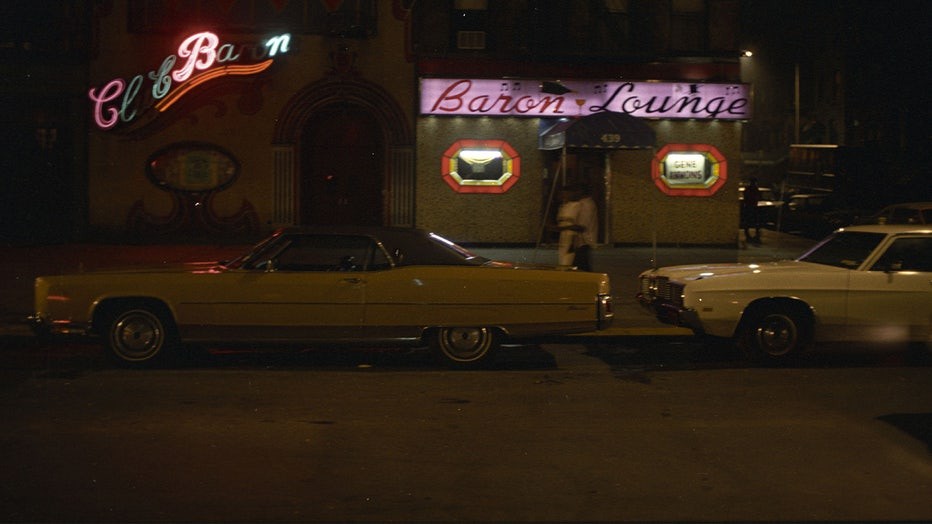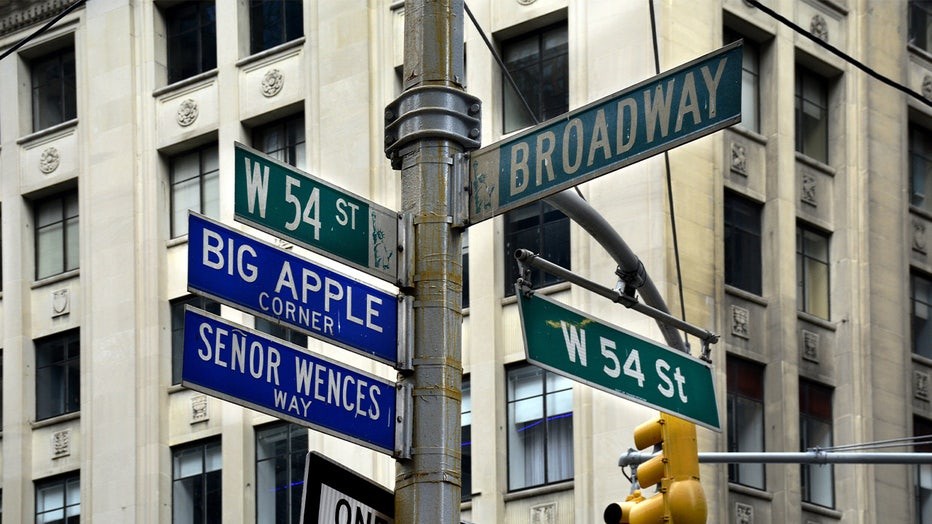Why Is New York City The Big Apple? Explore the captivating story behind New York City’s iconic nickname with WHY.EDU.VN. We unravel the historical roots, cultural influences, and marketing genius that cemented “The Big Apple” as a symbol of the city that never sleeps. Uncover the legacy and symbolism.
Table of Contents
- The Genesis of “The Big Apple”
- Early Mentions of “The Big Apple”
- John J. Fitz Gerald and the Horse Racing Connection
- Jazz Age Influence on “The Big Apple”
- The 1970s Tourism Campaign
- NYC Before “The Big Apple”: A Look at New Amsterdam
- The Enduring Appeal of “The Big Apple”
- Related Nicknames of New York City
- Modern Interpretations of “The Big Apple”
- Why New York City Continues to Attract People
- The Economic Significance of the Nickname
- Cultural Impact of “The Big Apple”
- The Allure of New York City: A Multifaceted Perspective
- How New York City Embraces Its Identity
- Why New York City Is a Global Hub
- The Big Apple in Popular Culture
- Exploring the Many Facets of New York City
- The Transformation of New York City Over Time
- Why New York City Is a Melting Pot of Cultures
- The Challenges and Triumphs of “The Big Apple”
- New York City’s Influence on Fashion and Trends
- The Future of New York City: Innovations and Growth
- Why New York City Is Synonymous With Opportunity
- The Role of “The Big Apple” in Shaping American Identity
- Why New York City Remains an Iconic Destination
- The Big Apple: A Symbol of Resilience and Reinvention
- Exploring New York City’s Diverse Neighborhoods
- Why New York City Is a Center for Arts and Innovation
- The Impact of “The Big Apple” on Global Perceptions
- Why New York City Is a City of Dreams and Aspirations
- Frequently Asked Questions (FAQ)
- Conclusion
1. The Genesis of “The Big Apple”
The moniker “The Big Apple” for New York City is more than just a catchy phrase; it’s a symbol steeped in history and cultural evolution. Originating in the early 20th century, the term initially referenced the numerous and prestigious horse racing circuits around New York City. According to the New York Public Library, these races offered substantial prizes, metaphorically “big apples,” attracting jockeys and stablehands eager to compete for the top rewards. The phrase captured the allure of New York as a place of significant opportunity and success, making it a destination of choice for those seeking to achieve greatness. Over time, this association with high stakes and grand prizes would evolve into the widely recognized nickname for the entire city.
2. Early Mentions of “The Big Apple”
Before it became a widespread symbol, “The Big Apple” was primarily a colloquial term circulating within specific communities. Historians like Barry Popik note that the phrase was commonly used among African American stablehands in the early 1900s. These workers, often traveling between different racing venues, used “Big Apple” to refer to New York City, where the rewards were the greatest. This early usage highlighted New York’s prominence in the racing world and its allure for those seeking professional advancement. The term was not yet widely known, but it had already begun to encapsulate the city’s reputation as a hub of opportunity and aspiration, setting the stage for its later adoption as the city’s official nickname.
3. John J. Fitz Gerald and the Horse Racing Connection
The popularization of “The Big Apple” is largely credited to John J. Fitz Gerald, a sportswriter for the New York Morning Telegraph. In the 1920s, Fitz Gerald began using the term in his column, “Around The Big Apple,” drawing inspiration from the African American stablehands he encountered in New Orleans. Fitz Gerald recognized the term’s potential to capture the excitement and prestige of the New York racing scene. By consistently using “The Big Apple” in his writings, he gradually introduced the phrase to a broader audience, associating it with the city’s vibrant sports culture and high stakes competition. This consistent exposure helped to cement the term in the public consciousness, paving the way for its eventual adoption as the city’s official nickname.
4. Jazz Age Influence on “The Big Apple”
The Jazz Age of the 1920s and 1930s further amplified the appeal of “The Big Apple.” As New York City became a cultural mecca for jazz musicians, the term evolved to represent the ultimate destination for artists seeking fame and fortune. Jazz musicians, drawn to the city’s vibrant nightlife and thriving music scene, began using “The Big Apple” to signify New York as the premier venue for performances. This association with jazz, a genre known for its innovation and energy, added a layer of sophistication and excitement to the nickname. Nightclubs and dance crazes, such as the “Big Apple” dance that swept Harlem in the 1930s, further solidified the term’s connection to the city’s dynamic cultural landscape.
5. The 1970s Tourism Campaign
In the early 1970s, New York City faced a period of economic decline and rising crime rates, tarnishing its image. To revitalize the city’s reputation and boost tourism, Charles Gillett, president of the New York Convention and Visitors Bureau, spearheaded a marketing campaign centered around “The Big Apple.” Inspired by the term’s historical roots and cultural associations, Gillett aimed to rebrand New York as a vibrant, welcoming destination. The campaign featured cheerful imagery of red apples, distributed T-shirts and promotional materials, and enlisted the support of celebrities. This strategic effort successfully transformed public perception, reminding people of New York’s unique charm and appeal. The campaign not only boosted tourism but also solidified “The Big Apple” as the city’s enduring nickname, symbolizing its resilience and enduring allure.
6. NYC Before “The Big Apple”: A Look at New Amsterdam
Before it was known as “The Big Apple,” New York City had a rich history under different names and influences. Originally founded by Dutch settlers in 1624, the city was named New Amsterdam after Holland’s largest city. New Amsterdam served as the capital of New Netherland and was a significant hub for the fur trade. The Dutch influence is still visible in some of the city’s oldest streets and architectural styles. In 1664, the English took control of the city and renamed it New York in honor of the Duke of York. Understanding this historical context provides a deeper appreciation for the layers of culture and identity that have shaped New York City into the global metropolis it is today.
7. The Enduring Appeal of “The Big Apple”
The enduring appeal of “The Big Apple” lies in its ability to encapsulate the multifaceted nature of New York City. The nickname evokes images of towering skyscrapers, bustling streets, and a vibrant cultural scene. It represents the city’s status as a global center for finance, fashion, arts, and entertainment. “The Big Apple” also symbolizes the opportunities and challenges that come with living in a city that never sleeps. Its catchy and memorable nature makes it easily recognizable and universally understood, contributing to its lasting popularity.
8. Related Nicknames of New York City
While “The Big Apple” is the most famous, New York City has acquired several other nicknames throughout its history, each reflecting different aspects of its character. “The City That Never Sleeps” highlights its 24/7 culture and vibrant nightlife. “Empire City” reflects its economic and political dominance, particularly during the late 19th and early 20th centuries. “Gotham,” a more literary nickname, evokes a sense of mystery and urban intrigue. These various nicknames collectively paint a comprehensive picture of New York City’s diverse and dynamic identity.
9. Modern Interpretations of “The Big Apple”
In modern times, “The Big Apple” continues to evolve, adapting to new contexts and trends. The nickname is used in various commercial and cultural endeavors, from the Big Apple Circus to sports teams and advertising campaigns. It appears in countless songs, movies, and books, solidifying its place in popular culture. The term also carries a sense of nostalgia, reminding people of New York City’s rich history and iconic status. Despite the city’s constant transformation, “The Big Apple” remains a timeless symbol of its enduring allure.
10. Why New York City Continues to Attract People
New York City’s magnetic pull on people from around the world is rooted in its unparalleled opportunities and vibrant culture. As a global hub for finance, media, fashion, and the arts, it offers diverse career paths and avenues for personal growth. The city’s dynamic atmosphere fosters innovation and creativity, making it an ideal environment for ambitious individuals. Moreover, New York City’s rich cultural tapestry, reflected in its diverse neighborhoods, cuisine, and artistic expressions, provides a unique and enriching experience. The city’s blend of opportunity and culture continues to draw people seeking to make their mark on the world.
11. The Economic Significance of the Nickname
The nickname “The Big Apple” has significant economic value for New York City. It serves as a powerful branding tool, attracting tourists, businesses, and investors. The city leverages its iconic nickname in marketing campaigns, promotional materials, and tourism initiatives. The association with “The Big Apple” enhances New York’s image as a premier destination, contributing to its economic prosperity. This branding effect underscores the importance of nicknames in shaping a city’s identity and economic success.
12. Cultural Impact of “The Big Apple”
“The Big Apple” has had a profound impact on global culture, shaping perceptions and inspiring artistic expression. The nickname has become synonymous with New York City’s vibrant arts scene, influencing music, film, literature, and fashion. Artists, writers, and filmmakers have drawn inspiration from the city’s dynamic atmosphere, contributing to its cultural legacy. The term “The Big Apple” also represents the city’s role as a trendsetter, influencing global styles and cultural movements.
13. The Allure of New York City: A Multifaceted Perspective
The allure of New York City stems from its diverse facets, each contributing to its unique appeal. Its towering skyscrapers and iconic landmarks evoke a sense of grandeur and ambition. Its vibrant neighborhoods, each with its distinct character and cultural influences, offer a rich tapestry of experiences. The city’s dynamic energy, fueled by its diverse population and endless opportunities, creates an atmosphere of excitement and possibility. These elements combine to make New York City a destination that captivates and inspires people from all walks of life.
14. How New York City Embraces Its Identity
New York City embraces its identity as “The Big Apple” through various cultural and civic initiatives. The city features “Big Apple” imagery in its branding, promoting its unique character and appeal. Street names, public art installations, and community events often incorporate the nickname, celebrating its historical significance. New York City’s embrace of its identity as “The Big Apple” fosters a sense of pride and unity among its residents, contributing to its distinctive cultural landscape. In recognition of Fitz Gerald, the corner of 54th and Broadway was renamed “Big Apple Corner” in 1997, according to Popik.
15. Why New York City Is a Global Hub
New York City’s status as a global hub is driven by its strategic location, diverse economy, and international connections. Its position as a major port and transportation center facilitates global trade and commerce. The city’s diverse economy, spanning finance, technology, media, and the arts, attracts businesses and talent from around the world. New York City’s international connections, fostered by its multicultural population and diplomatic presence, enable it to play a central role in global affairs. These factors combine to make New York City a vital link in the global network.
16. The Big Apple in Popular Culture
“The Big Apple” is ubiquitous in popular culture, appearing in countless movies, songs, books, and television shows. Its presence in media reinforces its status as a global icon, shaping perceptions and inspiring creativity. The nickname often symbolizes ambition, opportunity, and the pursuit of dreams. Its consistent portrayal in popular culture contributes to its enduring appeal and universal recognition.
Examples of “The Big Apple” in Popular Culture:
| Media Type | Example | Description |
|---|---|---|
| Movies | King Kong (1933) | Kong’s rampage through New York symbolizes the city’s overwhelming nature. |
| Songs | “Theme from New York, New York” | Celebrates the city as a place where dreams can come true. |
| Books | The Catcher in the Rye by J.D. Salinger | Captures the disillusionment and alienation of youth amidst the backdrop of New York City’s fast pace. |
| Television | Friends | Although set in New York, it presents a somewhat sanitized version of city life. |




17. Exploring the Many Facets of New York City
New York City’s diverse facets offer endless opportunities for exploration and discovery. Its five boroughs each boast unique neighborhoods, cultural attractions, and historical landmarks. From the iconic skyscrapers of Manhattan to the vibrant arts scene in Brooklyn, each borough offers a distinct experience. Exploring New York City involves immersing oneself in its diverse cultures, cuisines, and artistic expressions, uncovering the hidden gems that make it a truly unique destination.
18. The Transformation of New York City Over Time
New York City has undergone significant transformations throughout its history, evolving from a Dutch trading post to a global metropolis. Its economic landscape has shifted from maritime commerce to finance, technology, and the arts. The city’s population has grown and diversified, reflecting waves of immigration and cultural exchange. These transformations have shaped New York City’s identity, contributing to its dynamic and ever-changing character.
19. Why New York City Is a Melting Pot of Cultures
New York City’s status as a melting pot of cultures is a result of its long history of immigration and cultural exchange. People from around the world have settled in New York City, bringing their traditions, languages, and customs. This cultural diversity is reflected in the city’s neighborhoods, cuisine, and artistic expressions. New York City’s multicultural environment fosters creativity, innovation, and a unique sense of community.
20. The Challenges and Triumphs of “The Big Apple”
New York City has faced numerous challenges throughout its history, including economic downturns, natural disasters, and social unrest. Despite these challenges, the city has consistently demonstrated resilience, reinventing itself and emerging stronger. New York City’s triumphs, from its economic resurgence to its cultural achievements, reflect its enduring spirit and determination. The city’s ability to overcome adversity has solidified its reputation as a symbol of hope and opportunity.
21. New York City’s Influence on Fashion and Trends
New York City has long been a trendsetter in fashion and style, influencing global trends and inspiring designers. Its vibrant street style, high-end boutiques, and fashion-forward culture make it a hub for innovation. New York Fashion Week, a bi-annual event, showcases the latest collections from top designers, setting the tone for the upcoming seasons. The city’s diverse population and artistic community contribute to its unique and ever-evolving fashion landscape.
22. The Future of New York City: Innovations and Growth
The future of New York City is marked by continued innovation and growth across various sectors. Technological advancements, sustainable development initiatives, and infrastructure improvements are shaping the city’s trajectory. New York City’s commitment to innovation is driving economic growth, creating new opportunities, and enhancing its quality of life. The city’s future promises to be one of progress, resilience, and continued global influence.
23. Why New York City Is Synonymous With Opportunity
New York City is synonymous with opportunity due to its diverse economy, thriving industries, and ambitious spirit. The city offers a wide range of career paths, from finance and technology to media and the arts. Its entrepreneurial ecosystem fosters innovation and supports new ventures. New York City’s reputation as a place where dreams can come true attracts ambitious individuals seeking to make their mark on the world.
24. The Role of “The Big Apple” in Shaping American Identity
“The Big Apple” has played a significant role in shaping American identity, representing the nation’s ambition, diversity, and cultural influence. The nickname has become a symbol of American innovation, creativity, and entrepreneurial spirit. New York City’s contributions to American culture, from its music and art to its fashion and cuisine, have shaped the nation’s identity. The city’s role as a melting pot of cultures has also influenced American values, promoting tolerance, diversity, and inclusion.
25. Why New York City Remains an Iconic Destination
New York City remains an iconic destination due to its unique blend of history, culture, and opportunity. The city’s iconic landmarks, vibrant neighborhoods, and world-class attractions draw visitors from around the globe. Its dynamic atmosphere, diverse population, and endless possibilities create an unforgettable experience. New York City’s ability to reinvent itself while preserving its rich heritage ensures its continued appeal as a premier destination.
26. The Big Apple: A Symbol of Resilience and Reinvention
“The Big Apple” has become a symbol of resilience and reinvention, reflecting New York City’s ability to overcome challenges and adapt to change. The city’s history is marked by periods of economic hardship, social unrest, and natural disasters. Despite these challenges, New York City has consistently demonstrated its ability to rebound, rebuild, and emerge stronger. Its resilience and reinvention have solidified its reputation as a city of hope and opportunity.
27. Exploring New York City’s Diverse Neighborhoods
Exploring New York City’s diverse neighborhoods is essential to understanding its unique character. Each neighborhood offers a distinct cultural experience, reflecting the traditions, languages, and cuisine of its residents. From the historic streets of Greenwich Village to the vibrant murals of Bushwick, each neighborhood tells a story. Exploring New York City’s neighborhoods provides insight into its multicultural identity and the rich tapestry of experiences it offers.
A Brief Look at Some of New York City’s Diverse Neighborhoods:
| Neighborhood | Borough | Key Characteristics |
|---|---|---|
| Greenwich Village | Manhattan | Historic, bohemian, known for its arts scene and LGBTQ+ community. |
| Harlem | Manhattan | Rich African American culture, jazz history, soul food. |
| Chinatown | Manhattan | Vibrant Chinese culture, traditional markets, delicious cuisine. |
| Little Italy | Manhattan | Italian heritage, restaurants, festivals. |
| Williamsburg | Brooklyn | Trendy, artsy, known for its hipster culture and independent businesses. |
| Astoria | Queens | Diverse, Greek heritage, great food scene. |
| The Bronx | The Bronx | Home to the New York Yankees, rich in history and culture. |
| Staten Island | Staten Island | More suburban feel, historic sites, beautiful parks. |
28. Why New York City Is a Center for Arts and Innovation
New York City’s status as a center for arts and innovation is driven by its vibrant creative community, world-class institutions, and supportive ecosystem. The city is home to numerous museums, galleries, theaters, and performance venues. Its diverse population and artistic traditions foster creativity and experimentation. New York City’s supportive ecosystem, including funding opportunities, mentorship programs, and collaborative spaces, enables artists and innovators to thrive.
29. The Impact of “The Big Apple” on Global Perceptions
“The Big Apple” has had a significant impact on global perceptions of New York City, shaping its image as a dynamic, cosmopolitan, and influential metropolis. The nickname has become synonymous with the city’s energy, opportunity, and cultural diversity. Its widespread use in media and popular culture has reinforced these perceptions, contributing to New York City’s global appeal.
30. Why New York City Is a City of Dreams and Aspirations
New York City is a city of dreams and aspirations, representing the pursuit of success, achievement, and personal fulfillment. Its dynamic atmosphere, diverse opportunities, and ambitious spirit inspire people to strive for greatness. The city’s history is filled with stories of individuals who have overcome challenges, achieved their goals, and made a lasting impact. New York City’s reputation as a place where anything is possible continues to attract dreamers and achievers from around the world.
31. Frequently Asked Questions (FAQ)
Q1: How did New York City get the nickname “The Big Apple?”
A1: The nickname originated in the 1920s among horse racing enthusiasts, referring to the prestigious New York City racecourses.
Q2: Who popularized the term “The Big Apple?”
A2: Sportswriter John J. Fitz Gerald of the New York Morning Telegraph popularized the term in his column.
Q3: What other nicknames does New York City have?
A3: Other nicknames include “The City That Never Sleeps,” “Empire City,” and “Gotham.”
Q4: Why was the corner of 54th and Broadway renamed “Big Apple Corner?”
A4: It was renamed in honor of John J. Fitz Gerald, who lived near that corner for 30 years.
Q5: How did the 1970s tourism campaign help solidify the nickname?
A5: The campaign used “The Big Apple” to rebrand New York City as a vibrant and welcoming destination.
Q6: What was New York City called before it was named New York?
A6: It was called New Amsterdam by the Dutch settlers.
Q7: How has “The Big Apple” impacted popular culture?
A7: It has been featured in countless movies, songs, books, and television shows, symbolizing ambition and opportunity.
Q8: Why is New York City considered a global hub?
A8: Due to its strategic location, diverse economy, and international connections.
Q9: How does New York City embrace its identity as “The Big Apple?”
A9: Through cultural and civic initiatives, branding efforts, and community events.
Q10: What makes New York City a city of dreams and aspirations?
A10: Its dynamic atmosphere, diverse opportunities, and ambitious spirit inspire people to strive for greatness.
32. Conclusion
“The Big Apple” is more than just a nickname for New York City; it’s a symbol of the city’s history, culture, and enduring spirit. From its origins in the horse racing world to its adoption as a tourism slogan, the phrase has evolved to represent the city’s unique blend of opportunity, diversity, and resilience. As New York City continues to transform and innovate, “The Big Apple” remains a timeless reminder of its iconic status and global appeal. Do you have more burning questions about New York City or any other topic? Visit why.edu.vn, where our team of experts is ready to provide you with accurate, reliable, and insightful answers. Contact us at 101 Curiosity Lane, Answer Town, CA 90210, United States, or reach out via Whatsapp at +1 (213) 555-0101.
